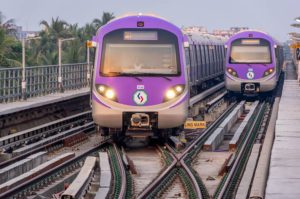BEML Rakes Touch 90 kmph: Kolkata’s East-West Metro, the country’s first underwater metro corridor, has reached another significant milestone. During multiple trial runs, Bharat Earth Movers Limited (BEML)-manufactured rakes clocked speeds of over 90 kmph, surpassing their official design limit and showcasing the efficiency of India’s indigenous metro engineering.
The achievement is not just about speed. It reflects years of technological progress, rigorous testing, and the promise of a smoother, more reliable commuting experience for lakhs of passengers in the coming years.

The Speed Trials That Impressed Engineers
According to Metro Railway sources, the speed trials were carried out on different stretches of the Green Line, which connects Salt Lake Sector V to Howrah Maidan. On straight stretches, the trains touched 90–92 kmph, while on curved alignments they maintained safe speeds between 40–50 kmph.
For daily operations, however, trains will run at moderated speeds — around 65–75 kmph on straight stretches — to ensure passenger safety, energy efficiency, and smooth braking. These trials, therefore, serve as proof of the rakes’ potential rather than an indicator of routine operations.
Engineering Behind the Achievement
The East-West Metro project has been a marvel of modern engineering, integrating technology at par with international standards. Some unique aspects include:
- Standard gauge tracks: Unlike the city’s older North-South line, the Green Line runs on 1435 mm standard gauge, allowing for higher speed and smoother turns.
- CBTC signaling system: Supplied by Hitachi Rail STS, the Communications-Based Train Control (CBTC) system allows for precise train movement, closer headways, and greater safety.
- Automation ready: The rakes are designed to operate in Automatic Train Operation (ATO) mode, where braking, acceleration, and halts are handled by software, leaving staff to supervise doors and safety mechanisms.
- Emergency backup locomotive: A battery-powered loco has been stationed to rescue stranded trains in case of power cuts — a first for Kolkata Metro.
Why These Rakes Matter for Kolkata
The BEML rakes were specifically designed for Kolkata’s challenging topography. The Green Line traverses tunnels beneath the Hooghly river, the deepest metro shaft in India, and stations located well below surface level.
The rakes come equipped with:
- Energy-efficient regenerative braking
- Noise reduction features for smoother passenger experience
- Spacious interiors with better standing capacity
- Disabled-friendly designs, including wider doors and priority seating
For a city where commuters have often faced overcrowding and delayed services, these modern rakes offer a refreshing shift.
The Bigger Picture: East-West Metro as a Game Changer
The East-West Metro Corridor is arguably one of the most ambitious urban transport projects in India. Once fully functional, it will drastically cut down travel time between Salt Lake IT hub and Howrah, one of the busiest railway junctions in the country.
- Total length: 16.6 km
- Underwater stretch: 520 metres beneath the Hooghly river
- Deepest station: Howrah, at 30 metres underground
The line is already easing pressure on roads and bridges. With operational efficiency backed by the new BEML rakes, daily ridership is expected to rise exponentially.
BEML’s Role in Indian Urban Transport
BEML has long been at the forefront of India’s rail and defense manufacturing. For Kolkata Metro, the company supplied 14 modern trainsets, each comprising six coaches.
The successful trials underline not just Kolkata’s progress, but India’s capacity to manufacture high-speed, metro-standard rolling stock domestically, reducing dependence on foreign imports.
Read more about BEML here:
👉 BEML Official Website
BEML Rakes Touch 90 kmph: Comparisons With Other Indian Metros
- Delhi Metro trains, supplied by BEML and international players, typically run at operational speeds of 80 kmph.
- Mumbai Metro also uses similar speed limits.
- Kolkata’s new rakes achieving over 90 kmph during trials is significant, showing how the East-West corridor is benchmarked against global standards.
Impact on Commuters
For passengers, this means:
- Reduced travel time: Salt Lake to Howrah in under 30 minutes.
- Reliable frequency: With CBTC, trains could eventually run at 150-second headways.
- Comfort and safety: Better ventilation, design, and automation improve overall travel quality.
Commuters, especially office-goers in Salt Lake Sector V and suburban travellers using Howrah station, are expected to be the biggest beneficiaries.
Expert Voices
Transportation experts believe the trials mark a turning point. Urban transport analyst Dr. Anindya Sanyal noted:
“Kolkata has historically lagged behind Delhi, Bangalore, and Mumbai in metro infrastructure. But the East-West corridor, with underwater tunnels and now high-speed rakes, puts the city back on the innovation map.”
What Lies Ahead
The Green Line is not just a metro corridor — it’s a vision of modern Kolkata. Once the entire line stabilizes with automated operations, it could pave the way for more driverless metro initiatives in India.
Officials are now focusing on:
- Completing passenger feedback studies
- Ensuring software readiness for ATO mode
- Integrating smart ticketing and app-based live train tracking
External References for More Reading
- Kolkata Metro – Green Line (Wikipedia)
- BEML India – Urban Transport Division
- Kolkata Metro Official Website
Also read: Home | Channel 6 Network – Latest News, Breaking Updates: Politics, Business, Tech & More

